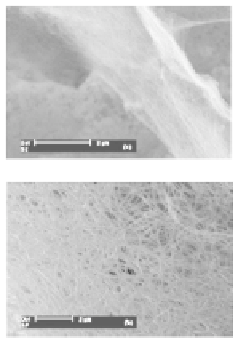Biomedical Engineering Reference
In-Depth Information
for alcohol detection at room temperature. Figure 9.12 shows the
scheme of the QCM and SOF transducer. Two different sensing
mechanisms have been used in order to outline the gas sensing
properties of this class of carbon-based nanomaterials: mass
loading and refractive index change due to gas absorption. Here, LB
films consisting of tangled bundles of SWCNTs without surfactant
molecules have been successfully transferred onto both QCM and
SOF. SEM images of the SWCNT films deposited onto QCM and SOF
are shown in Fig. 9.12. The CNTs horizontally deposited form a net
of nanotubular chains densely distributed with tangled bundles
of SWCNTs mats. This geometry is very useful for gas adsorption.
Mass-sensitive 10 MHz QCM SWCNT sensor exhibited a resonant
frequency decreasing upon tested alcohols exposure; also the
normalized optoelectronic signal (
= 1310 nm) of the refractive
index-sensitive SOF SWCNT sensor was found to decrease upon
alcohols ambient. Highly sensitive, repeatable and reversible
responses of both QCM and SOF SWCNT sensors indicate that the
detection, at room temperature, in a wide vapor pressure range
(30-200 mmHg) of alcohols and potentially other volatile organic
compounds is feasible.
l
Figure 9.12
Cross-sectional view of the (a) QCM sensor using carbon
nanotubes. Cross-sectional scheme of the (b) SOF with a
cleaved and unclad end coated by carbon nanotubes onto
buffer multilayer of cadmium arachidate (CdA). SEM images
of LB films of single-walled carbon nanotubes onto (
a-upper
)
quartz and (
) silica optical fiber, both buffered by CdA
multilayer. This figure is reprinted with permission from
AIP [153].
b-lower




